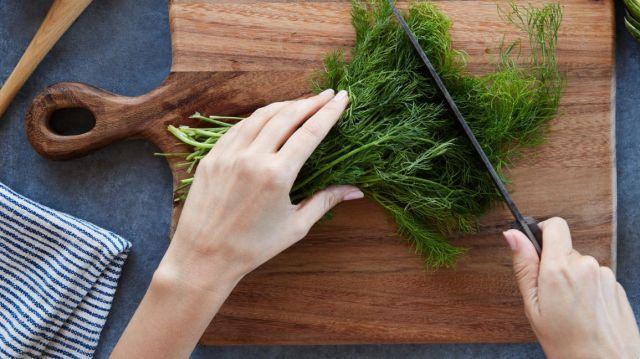
Dill is an aromatic herb useful for flavoring dishes and as a natural remedy to improve cardiovascular health, of the bones and not only. Let's find out better.
- What is dill
- Description of the dill plant
- Where is dill found
- How to grow dill in pots
- Properties and benefits of dill
- Calories and nutritional values of dill
- Recipes with dill
- Curiosities about dill
What is dill
Dill is an aromatic herb of which you can use leaves or seeds, which have different organoleptic properties. In particular, while dill leaves have a sweet taste, the seeds have a slight hint of citrus and they are similar to cumin seeds.
Description of the dill plant
L'aneto (Anethum graveolens) it is a herbaceous plant with small yellow flowers belonging to the Apiaceae family and originally from India. Today it is also widespread in Europe, in regions such as France and Austria, however, in the country it is quite rare and is found mainly in the northern area.
It is very popular as an aromatic herb in both Asian and European cuisine. You can use both sweet tasting leaves and the seeds are brown in color and have a more aromatic flavor and pungent
Where is dill found
The dill plant is of Asian origin, but today it is also widespread in Europe, in regions such as France and Austria. However, the cultivation of dill in the country is quite rare and is mainly present in the northern area.
How to grow dill in pots
For those who want to always have fresh dill available, the dill plant can also be grown in pots.
It will be enough plant the seeds to a depth of about 3 cm, covered with soil and possibly adding fertilizer.
It is important that the plant is well exposed to the sun and is constantly hydrated as soon as the soil is dry.
About 6-8 weeks after sowing, it will be possible to collect the leaves.
Properties and benefits of dill
In addition to being useful for flavoring dishes, ldill has excellent properties and health benefits. Let's see some of them:
- Dill is rich in antioxidants such as flavonoids, terpenoid e tannins, associated with lower risk of chronic disease and greater cardiovascular, mental health and longevity.
- Thanks to the presence of monoterpenes, reduces the risk of colon, lung and breast cancer.
- Favors bone health, thanks to the presence of calcium, magnesium and phosphorus.
- Enhance levels of cholesterolemia and triglycerides.
- Enhance levels of blood sugar.
- Presents antibacterial properties.
- Counteracts menstrual pains.
Calories and nutritional values of dill
100 g of fresh dill leaves provide:
- 43 kcal
- 3,4 g protein
- G carbohydrates 7
- 1,1 g fat
- Fiber 2,1 g
Dill is rich in vanadium: discover the properties of this mineral
Recipes with dill
Dill in cooking is quite versatilein fact, the flavor of dill is similar to fennel and anise and can be used to enhance the flavors of dishes and reduce the consumption of salt.
Both dried leaves and seeds can be used and is well suited for flavoring soups, vegetables, salads, potatoes, salmon, eggs, pickles, yoghurt-based sauces and marinades.
There are several recipes with dill, among the most popular, certainly falls pairing with salmon.
In order to always have it available, you can use thedry dill, useful to keep in the pantry all year round.
Curiosities about dill
- The dill he was much loved in ancient Rome and it was used a lot especially by gladiators, as it was believed to have useful properties to increase physical strength.
- In Roman times dill seeds were used as a kind of chewing gum, to freshen your breath.
- In the United States, dill seeds were given to children to chew to keep them calm during religious services and were therefore called "meeting seeds".
READ MORE
Dill among the natural remedies for brittle nails
Other articles on dill:
-
Dill among the ingredients of Ayurvedic herbal teas
Bibliography and sources
Anethum graveolens: An Indian traditional medicinal herb and spice, Pharmacognosy reviews
Flavonoid intake and mortality from cardiovascular disease and all causes: A meta-analysis of prospective cohort studies, Clinical nutrition ESPEN
Anethum graveolens and hyperlipidemia: A randomized clinical trial, Journal of research in medical sciences : the official journal of Isfahan University of Medical Sciences
The Role of Anethum graveolens L. (Dill) in the Management of Diabetes, Journal of tropical medicine
d-limonene exhibits antitumor activity by inducing autophagy and apoptosis in lung cancer, OncoTargets and therapyd-limonene exhibits antitumor activity by inducing autophagy and apoptosis in lung cancer, OncoTargets and therapy
Antibacterial and phytochemical screening of Anethum graveolens, Foeniculum vulgare and Trachyspermum ammi, BMC complementary and alternative medicine
Effect of Dill (Anethum graveolens) on the severity of primary dysmenorrhea in compared with mefenamic acid: A randomized, double-blind trial, Journal of research in medical sciences : the official journal of Isfahan University of Medical Sciences
FoodData Central, U.S. DEPARTMENT OF AGRICULTURE


























